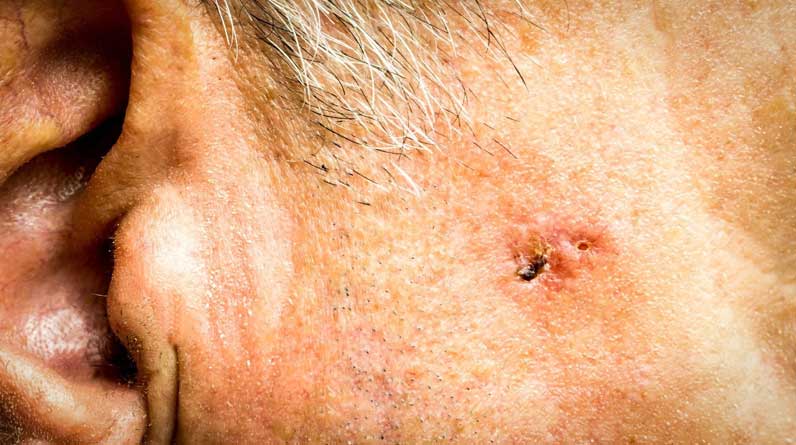
Types and Treatment of Skin Cancer
Skin cancer is the most common form of cancer in the United States and worldwide. In fact, more than 9500 people daily get diagnosed with skin cancer, and among those, two people die every hour from the disease.
While this is an extremely unfortunate statistic, and it can certainly be an unpleasant form of cancer; fortunately, skin cancer, depending on the level of severity, CAN be treated and CAN be reversed in most cases.
Let’s discuss and highlight what skin cancer is and the various types of skin cancer, how it can be caused, and what can be done to treat it. This information can be extremely useful in helping you to prevent what can be a difficult illness.
What is Skin Cancer?
Skin cancer is the result of the rapid growth of skin cells and is more often than not the result of excessive exposure to the sun over time. While this isn’t the only factor, it’s important to monitor your exposure to ultraviolet light in order to reduce your chances of getting skin cancer.
While not all skin cancers are created equal, nor do they elicit the same symptoms, it’s important to bring any worrisome skin abnormality to the attention of a physician.
If caught early, skin cancer is treated successfully, and in most cases, curable.
Some of the most common signs and symptoms that arise with those that find out they have skin cancer:
- Discoloration: if you find spots on your skin of a different color than the surrounding skin, this may be an indicator of skin cancer.
- Skin Lesions: lesions like new growths, moles, bumps, or sores can be a sign of skin cancer.
- Size of Lesion: While many lesions turn out to be benign, the lesions that are worrisome typically grow in size over time.
- Pain or Itchiness of Skin: If a particular rash, mole, and lesion of any kind become sore or painful, this could be a sign of skin cancer. It’s best to have this examined by a Dermatologist to confirm the diagnosis.
Types of Skin Cancer
There are three types of skin cancer, generally speaking. Those types are as follows:
- Basal Cell Carcinoma
- Squamous Cell Carcinoma
- Melanoma
Melanoma is a very uncommon form of skin cancer, but it’s also the most dangerous. It has the ability to spread throughout the entire body aggressively. Melanoma is, however, very rare, and it only makes up about one percent of all skin cancer cases.
Carcinoma, on the other hand, is the most common form of cancer, accounting for almost 90% of all skin cancer cases. Carcinoma is a form of cancer that develops on the outer layer of the skin and typically shows itself as lesions, bumps, or masses of some kind. There are two types of carcinoma: Basal Cell and Squamous Cell.
While some skin cancers are more common than others, all can be treated if caught early enough. Some skin cancers will have different symptoms, but most are relatively similar to one another.
What Causes Skin Cancer?
As discussed earlier, skin cancer is largely a result of overexposure to UV light and occurs as cells regenerate at rates faster than normal.
Those at greater risk of skin cancer are those with light skin and less pigment and those from warmer regions much more sun exposure for longer periods of time.
Older individuals who have a history of excessive sun damage to the skin are also at increased risk.
Skin Cancer Treatments
Early-onset skin cancer or pre melanoma is highly treatable, and in most cases, curable. As with any cancer or chronic disease, however, there are levels of severity, and if not treated early, they can advance to a terminal condition.
Several skin cancer treatments are available. These are some of the most common treatments of skin cancer:
- Chemotherapy – Oral medication, topical medication, or injection at the site of cancer.
- Radiation – directed energy to kill cancer at the root.
- Immunotherapy – topical cream used to stimulate immunity and eliminate cancer cells.
- Cryotherapy – liquid nitrogen used to freeze cancer growth.
- Surgery (Mohs, Excision, etc.) – executed to remove skin cancer at the source.
While treatment depends on severity and type, all treatments have shown their own effectiveness and purpose. It’s wise to ask your Dermatologist about what treatment may be right for you and what options you have at your disposal.
Chemo and radiation, for example, are typically for more invasive, severe cases, while cryotherapy is a more holistic approach to cancer types that are less severe and more treatable.
Final Thoughts
Skin cancer is a frequently encountered disease that primary care physicians see on a regular basis. Referral to a dermatologist is the standard practice. It is beneficial to do everything possible to mitigate cancer from getting worse. Being proactive will improve remission rates and prevent it from coming back.
This proactive behavior includes catching the disease early and avoiding sun exposure by wearing protective gear and using adequate sunscreen on targeted areas. Such preventive measures can prevent this problem throughout life.

